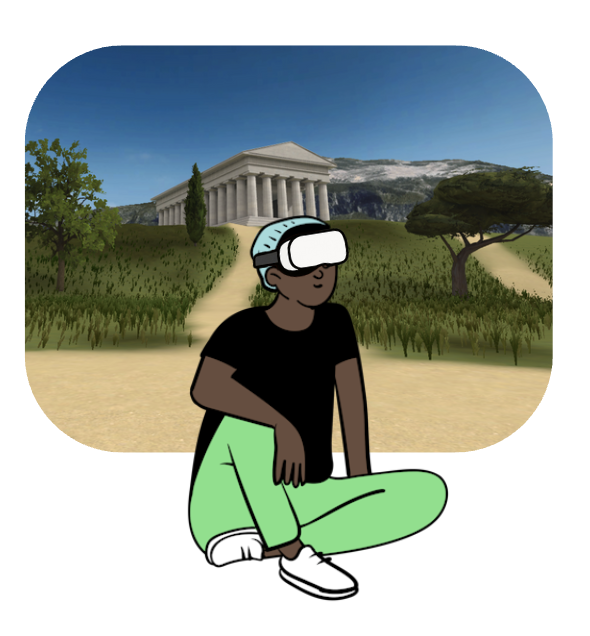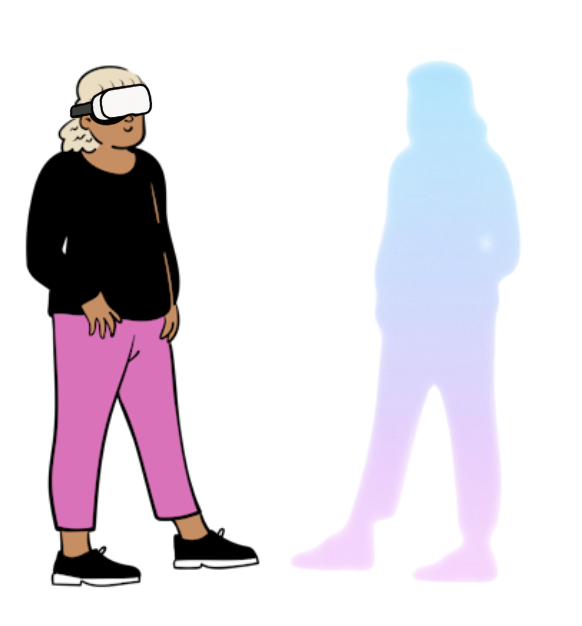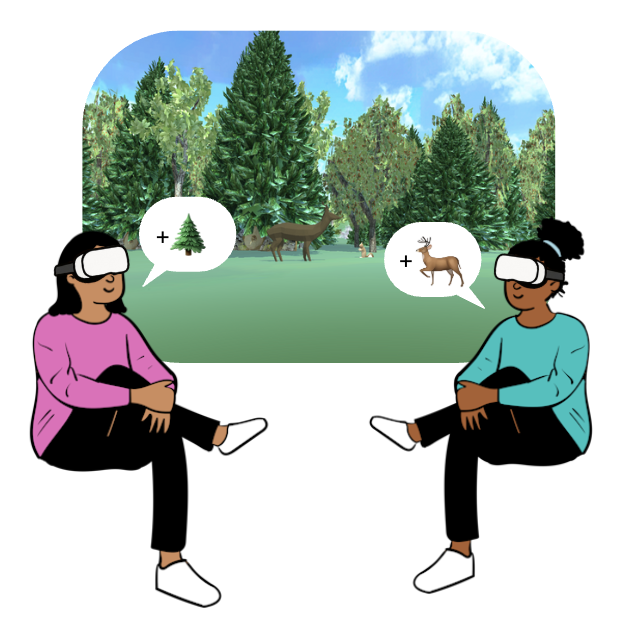My name is Cyan DeVeaux. I’m a fifth-year Ph.D. Candidate at Stanford University advised by Professor Jeremy Bailenson and Professor James Landay. As a member of the Virtual Human Interaction Lab and Human-Computer Interaction Group, my work exists at the intersection of media psychology, design, and digital studies. My research investigates social and embodied experiences within AR/MR/VR with a focus how people learn, connect, and express themselves within the medium. Through experimental studies, digital ethnography, and design, I explore the psychobehavioral implications of AR/MR/VR, and how these technologies shape education, social interaction, and digital self-representation. In doing so, my goal is to imagine futures where immersive media foster joy, inclusion, and enrichment.
I am supported by the Joyful Learning Seed Grant, NSF Graduate Research Fellowship, Stanford Graduate Fellowship in Science & Engineering, Enhancing Diversity in Graduate Education Doctoral Fellowship, and Technology & Racial Equity Graduate Fellowship. I am also a Research Affiliate at the University of Michigan Intersectional Tech Lab working with Professor Kishonna Gray. Over the past summers, I worked as a Research Scientist Intern at Meta Reality Labs Research on the Audio Team and Microsoft Research on the Speaking the World into Existence Team. Previously, I worked at Google as a Software Engineer and earned an interdepartmental B.A. in Computer Science and Visual & Media Studies from Duke University.
Research Themes
My work explores how immersive technologies shape learning, connection, and expression across three themes. Each reflects my interest in centering human experience, including identities and group interaction, within AR, MR, and VR design.
Immersive Learning
I design and study immersive environments that support education. This work examines how embodied interaction and spatial presence can foster novel forms of learning,
DeVeaux, C., & Bailenson, J. (2022). Learning about VR in VR. XRDS: Crossroads, The ACM Magazine for Students, 29(1), 14-19.
Cheng, A. Y., Ritchie, J., Agrawal, N., Childs, E., DeVeaux, C., Jee, Y., ... & Landay, J. A. (2023, April). Designing immersive, narrative-based interfaces to guide outdoor learning. In Proceedings of the 2023 CHI Conference on Human Factors in Computing Systems (pp. 1-22).
Han, E., Miller, M. R., DeVeaux, C., Jun, H., Nowak, K. L., Hancock, J. T., ... & Bailenson, J. N. (2023). People, places, and time: a large-scale, longitudinal study of transformed avatars and environmental context in group interaction in the metaverse. Journal of Computer-Mediated Communication, 28(2), zmac031.
Embodiment & Identity
Through both qualitative and experimental work, I investigate how design choices in immersive systems influence how people feel seen and experience avatar embodiment in digital spaces.
DeVeaux, C., Han, E., Hudson, Z., Egelman, J., Landay, J. A., & Bailenson, J. N. (2025). Black immersive virtuality: Racialized experiences of avatar embodiment and customization among black users in social VR. Computers in Human Behavior, 168, 108639.
DeVeaux, C., Han, E., Landay, J. A., & Bailenson, J. N. (2023). Exploring the relationship between attribute discrepancy and avatar embodiment in immersive social virtual reality. Cyberpsychology, Behavior, and Social Networking, 26(11), 835-842.
Kim, S., DeVeaux, C., Tao, Y., Srirangarajan, T., & Bailenson, J. (2025, August). BEASTS: Dual Perspectives on Virtual Puppetry through Theatrical Expression and XR Research. In Proceedings of the Special Interest Group on Computer Graphics and Interactive Techniques Conference Spatial Storytelling (pp. 1-3).
Collaborative Creation & Co-presence
I study co-presence and co-creation in virtual worlds, examining how people build and communicate together within shared immersive spaces. This work explores both the design of multi-user environments that foster the feeling of “being there” together and the behavioral signals that shape and reflect that sense of presence.
Kobenova, A.*, DeVeaux, C.*, Parajuli, S.*. Banburski-Fahey, A., Fernandez, J. A., & Lanier, J. (2024). Social Conjuring: Multi-User Runtime Collaboration with AI in Building Virtual 3D Worlds. arXiv preprint arXiv:2410.00274.
DeVeaux, C., Markowitz, D. M., Han, E., Miller, M. R., Hancock, J. T., & Bailenson, J. N. (2024). Presence and pronouns: an exploratory investigation into the language of social VR. Journal of Language and Social Psychology, 43(4), 405-427.
Bailenson, J. N., Beams, B., Brown, J., DeVeaux, C., Han, E., Queiroz, A. C., ... & Wang, P. (2024). Seeing the world through digital prisms: Psychological implications of passthrough video usage in mixed reality.



